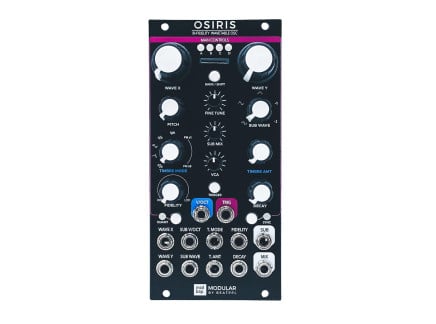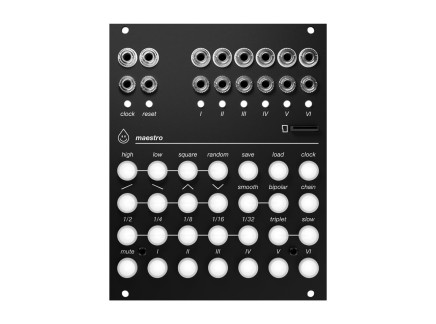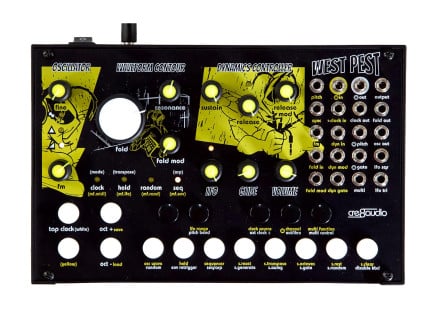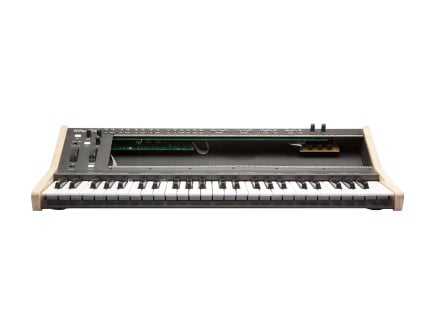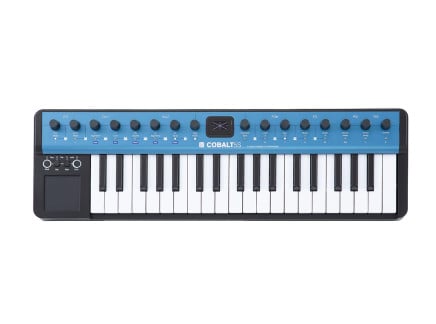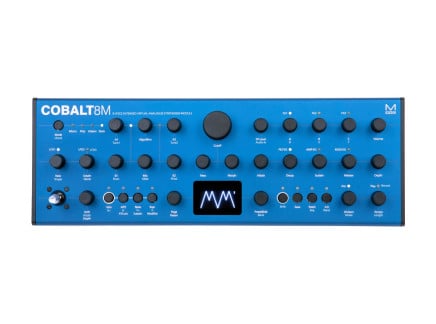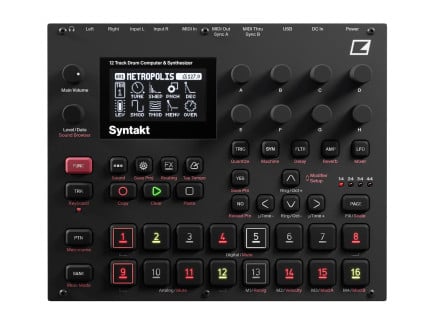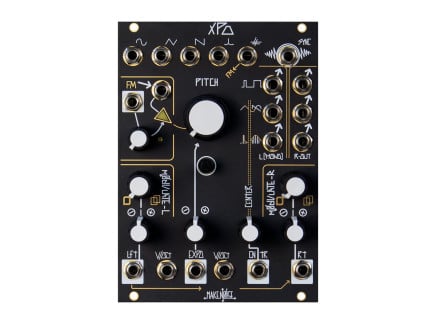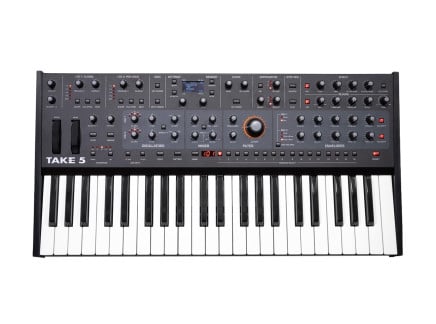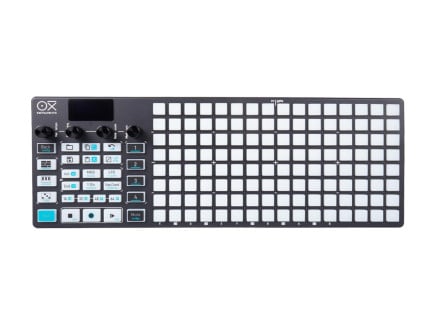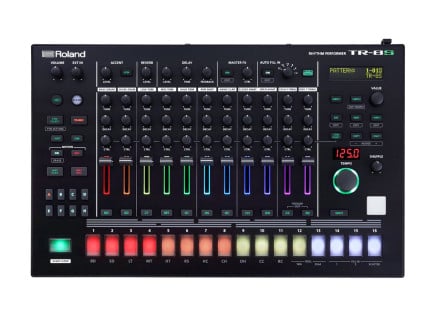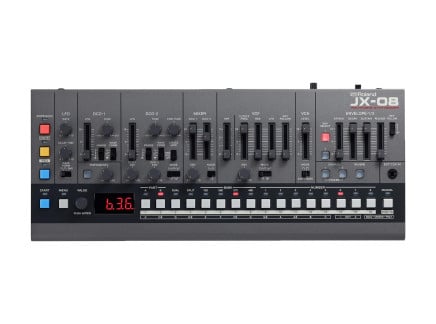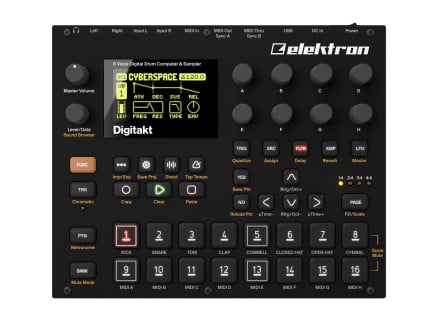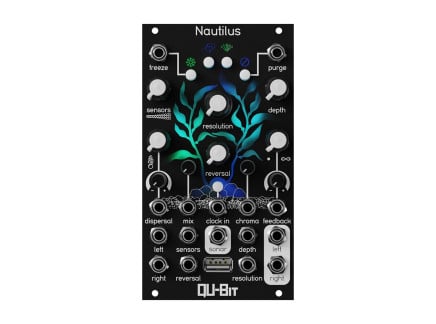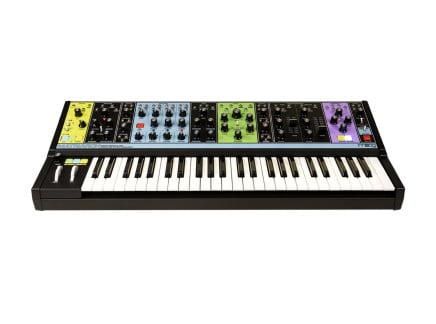As another year begins to wind down, we're taking a look back at all the awesome gear that came our way. From synthesizers, drum machines, and Eurorack modules to samplers and effects, it was a year full of wild and wacky new inventions—and new inspiration.
So, we reached out to some of our favorite artists and internet creators to fill us in on their year, specifically asking them one simple question: what was the coolest piece of gear you got this year? For some, that meant game-changing new releases, and for others, it meant sitting down and finally getting to know some modern classic instruments.
Click here if you're returning and want to jump straight to our newest additions—and be sure to head over to our Staff Picks 2022 article for some more ideas about rad gear from 2022. Or alternatively, read on to see the full list of our pals' favorite electronic music gear available today.
Round 1: Emily Hopkins, Starsky Carr, Red Means Recording, and Even More Pals
In our first round of year's-end recommendations, we heard from loads of rad creators—the techno-loving Ihor, harpist + effect enthusiast extraordinaire Emily Hopkins, composer Starsky Carr, Robin Vincent of Molten Music Technology, our pal and music production whiz Red Means Recording, guitar effect pedal freakout wizard Cyberattack, and our friend Dean from Electronisounds Audio.
Quite the colorful crew, their recommendations range from new Eurorack modules and grooveboxes to effect pedals, experimental drum machines, keyboard synthesizers, and more. Check out the video above to hear it all straight from them—and read on for our thoughts about everything they chose as their favorite gear of the year.
Modbap Modular Osiris Bi-Fidelity Wavetable Oscillator
We'll start out with one of our pal Ihor's picks. Modbap Modular has consistently rolled out out unique modules that fuse the world of Eurorack synthesizers and hip-hop—quite in line with the general Modbap musical aesthetic. Osiris is their first dedicated oscillator module…and it is an absolute powerhouse.
Built around a wavetable oscillator architecture, Osiris is preloaded with 4 banks of 32x32 wave tables that are scannable with the X and Y Wave knobs. This module is capable of acting as a full synth voice, with a built-in VCA with manual trigger and Decay knob. This makes it perfect for smaller systems, especially if you're looking for great percussive sounds.
A built in Sub option is somewhat typical on oscillators, but the Osiris takes it one step further by letting you independently control the pitch of the Sub, effectively giving you two oscillators in one package. The Timbre Mode opens up a huge amount of sonic sculptability with waveshaping modes, FM, and detuning for almost endless possibilities. On top of all that, Osiris uses Bi-Fidelity to let you keep the audio in high quality 96k or dip it down using the Fidelity knob to dial in the perfect amount of subtle downsampled grit.
Modbap's Osiris takes the idea of a wavetable Eurorack oscillator, puts their own spin on it, and adds the perfect amount of functionality.
Acid Rain Technology Maestro: A Multitude of Modulation
Another top choice from Ihor, Acid Rain Technology's Maestro is a 6-channel playable modulation source that uses a gently-lit button matrix for quick parameter access and assignment. There is no deep menu diving—instead, everything is laid out neatly on the button matrix.
Using the channel buttons, you can assign modulation sources to multiple channels at the same time, mute modulation channels, and make changes on the fly. There aren't a huge amount of modules that focus on the playability of a patch, and in Eurorack, it's all about modulation, so it makes sense to have a module that lets you quickly change modulation types…allowing you to get more out of even the simplest of patches.
Maestro lets you choose from ramp up, down, triangle, inverted triangle, square, random, high, and low modulation types, with the option to change whether you're using a unipolar 0–5V or bipolar -5V–+5V range at the press of a button. Everything is tied to a clock and, of course, the divisions and multiplications are easily accessible, letting you create rhythmically quantized adjustments that are perfect for percussive patches and intricate melodies. A unique modulation Chain option is available that lets you create a modulation sequence of sorts, with each iteration able to have its own rhythmic division.
Maestro is beyond a simple LFO or CV source—it can do that, of course, but it is also capable of so much more. Once you get your hands on the satisfying matrix and start to see how easy it is to use, you'll be hooked. Acid Rain Technology continues to innovate.
Andrew Huang x Endorphin.es GHOST Eurorack Multi-Effect Module
If you have been on YouTube looking at music at all in the past several years, you definitely know the name Andrew Huang—and this year he has collaborated with Endorphin.es to create the GHOST module. It's the final recommendation from our pal Ihor.
GHOST is a multifunction effects module that combines distortion, filter, delay, reverb, and compression effects into one powerful module. Its ingenuity lies at the three-way routing switch that lets you place the FX before the distortion which goes into the filter, the distortion into the filter then into the FX, or the filter into the FX then into the distortion.
The effects you get are a delay with multiple taps, which you can set up in a few different stereo modes, and a hall reverb with adjustable Tail length, plus a Freeze button that locks in the reverb tail. The ability to route this on the fly makes the GHOST exceptionally versatile, as you can go from glacial expanses to gritty noise in seconds. There are three points of overdrive on the GHOST: the Tone's secondary function is a gain control that can drive the Distortion; of course the Distortion circuit and corresponding knob will give you a nice warm saturation; and on the final Output volume, the last quarter turn with give you some high-end crunch.
It's hard to ignore the giant filter knob in the center, and it is truly one of the most expressive controls on the module. Instead of choosing between low pass and high pass, you get both: by turning CCW you get a low pass filter and CW gives you a high pass. You can also set it into a band pass mode or change it to be a comb filter—when combining this with the distortion in the front or back, just about any sound can be dialed in. For a small system—or a large one—GHOST checks a lot of boxes.
Emily Hopkins Goes Modular with the Moog Sound Studio
Ask almost anyone what they think of when they hear the word "synthesizer" and there's a good chance that a Moog instrument comes to mind. As such, Moog's semi-modular instruments are a popular starting point for anyone interested in exploring modular synthesis.
Between the Mother-32, DFAM, and Subharmonicon, any of those instruments alone would offer a new and exciting sonic world on their own, but the possibilities are drastically increased when you pair two or more of them together. Moog themselves realized this as their semi-modular ecosystem grew larger, and began bundling them together in collections known as Mother-32 and DFAM. Between the Mother-32's straight-ahead subtractive synthesis architecture and the DFAM's punchy, all-analog drum sounds, this Sound Studio package delivers all of the quintessential Moog sounds. Thick basses, fluttery arpeggios, gritty kicks, and experimental sci-fi textures are all easily achieved. And because both instruments are highly patchable, you can customize their signal paths to your liking or even use one to modulate or affect the other.
Regardless of which package you pick, all Sound Studios come with a number of accessories and trinkets to get you started. From patch guides and exercises to the included stand and audio mixer, a Moog Sound Studio is truly a central hub in which you can begin (or extend) your modular synthesis journey. And of course, remember that Moog's individual semi-modular synths pack a lot of power as well: in fact, our pal Miles Kvndra picked the Mother-32 as his top acquisition of 2022 (as you'll see in a video below!).
Oberheim OB-X8: Perhaps the Best Analog Polysynth Ever?
The return of Tom Oberheim with the new analog eight-voice polysynth OB-X8 is undoubtedly one of the most exciting events in recent synth history. The instrument embodies the rich legacy of its inventor, and being one of the last projects that Dave Smith was involved in before his passing, the arrival of OB-X8 furthermore holds a sentimental value for the synthesizer community. This made it Starsky Carr's top pick of 2022.

Cleverly combining the distinctive features of the iconic OB-X, OB-Xa, and OB-8, the instrument assumes the spot as the ultimate Oberheim synthesizer, and it further justifies its rightful position by offering a collection of faithfully recreated factory sounds from all of the original models. Moreover, OB-X8 is bi-timbral, allowing the performer to simultaneously interact with two distinctly different sounds, and construct thick, warm, and multilayered textures.
The instrument sports two SEM/OB-X-lineage oscillators per voice with a selection of triangle, saw, and pulse wave shapes, and the sound can be further enhanced by combining pulse and sawtooth waves, as well as enabling cross-modulation and hard-syncing effects. The instrument also includes an analog noise source which can be added to the sounds of oscillators in the desired amount. OB-X8 boasts three unique filter configurations that clearly define the character of the instrument. For classic OB-X tones, there are discrete SEM-lineage filters expanded to feature high-pass, band-pass, and notch filter types besides the classic lowpass. The sonic richness of OB-Xa and OB-8 can also be reached thanks to the inclusion of the classic 2- and 4-pole Curtis CEM3320 filter.
The modulation on OB-X8 similarly expands on the original models. Both volume and filter envelopes can be assigned a dedicated mode that captures the exact timing and curvature of OB-X/Xa or OB-8 synthesizers. And the multi-waveshape LFO can be easily assigned to critical parameters to achieve animated filter sweeps, pwm, vibrato, tremolo, and other effects. The instrument also sports a comprehensive control section that allows the user to adjust portamento, and oscillator 2 detune amounts, selectively assign aftertouch and velocity to volume or filter frequency cutoff, enable unison mode, and regulate the variability in the behavior of different elements via the "Vintage" control. The synthesizer is complete with a high-quality 61-key Fatar keyboard, complemented with a classic Oberheim pitch and mod levers, and an OB-8-style arpeggiator.
In all truth, OB-X8 is as close to perfection as it gets in terms of analog polysynths. Its build quality and sound are remarkable, and there really is no other instrument out there that is similarly capable of delivering such an authentic feel and character of several legendary Oberheim instruments. Assuredly, OB-X8 is destined to become the future classic.
An Enduring Favorite Oddball: SOMA Laboratory Pulsar-23
It is difficult to imagine someone maintaining their regular facial expression upon a first encounter with the Soma’s Pulsar-23. The interface of what the company calls an "organismic drum machine" is simultaneously perplexing and alluring. This is not incidental, as Vlad Kreimer, the chief creator of the instrument, took a series of radical design decisions that don’t merely contribute to the esoteric character of the drum machine, but above all turn out to be functionally practical, and creatively stimulating. It was another of Starsky Carr's picks this year.
In essence, Pulsar-23 is a semi-modular 4-voice drum synthesizer that sports an amalgam of unusual features and workflow possibilities. For one, It does away with the usual 1/8” and 1/4” patch points in favor of rudimentary binding posts for alligator clips. This opens up a few possibilities. One, it offers an easy solution for combining and distributing multiple signals without the need for dedicated mults, mixers, or stackable cables. Two, it allows the performer to make connections using their body, therefore inviting spontaneous and instinctive gestural performance practices. Three, Pulsar-23 is a virtually endless playground for feedback patching that can be really exciting both sonically, and on a level of personal discovery. Importantly, the binding posts and alligator clips don’t prevent the instrument from interfacing with other equipment, as it includes MIDI-CV, and 1/4” and 3.5mm converters right on board.
The four original voices on the drum machine are BD, BASS, SD, and HHT—each one contributing to the rich palette of the instrument. Moreover, the voices are surrounded by a variety of modulators, utilities, and sound processors. Among them are a versatile pseudo-random generator Shaos, a variable-waveshape LFO, digital delay and reverb effects, a master distortion, touch-sensing CV sources, attenuators, and a robust analog clock interface. Pulsar further deviates from the traditional conceptions of drum machines in that it lacks a step-sequencer, and instead features a dedicated phrase looper for each of the voices. This additionally adds to the necessarily fluid and natural behavior of the device. By all means, P-23 is one of the most unusual instruments one may find, and it is guaranteed to be a great acquisition for any adventure-loving sonic explorers.
Budget-Minded Semi-Modular: Cre8audio / Pittsburgh East Beast + West Pest
Created in collaboration between Cre8Audio and Pittsburgh Modular, East Beast and West Pest are semi-modular synthesizers that collectively present a great framework for exploring two distinctive approaches to sound synthesis. Named with a respective reference toward the so-called “east coast” and “west coast” schools of synthesis, the two instruments are among the most affordable in that category, yet remarkably versatile and great-sounding. Importantly, both instruments are designed to be easily integrated into a variety of studio and performance situations, thanks to their 20-point patch bay, and full MIDI integration. These were another of Starsky Carr's personal picks this year.

East Beast is a classic monophonic subtractive synthesizer featuring a single multi-waveshape analog oscillator, a PGH-signature multi-mode resonant filter, a VCA, an ADSR envelope, a dual-range triangle-wave LFO, a digital multi-mode modulation source, a 32-step sequencer, and an arpeggiator. In its default state, all of the traditional mono synth sounds are readily available, and a few knob twists can already be enough to switch from funky bass to screaming leads to percussive hits, however, the patch bay on the instrument offers access to more advanced synthesis techniques including pulse width modulation and FM.
West Pest is also a monophonic analog synthesizer, though it offers a distinctly contrasting Buchla-esque approach to sound synthesis. The core elements of the instrument are the oscillator with selectable sine, saw, and triangle waveshapes, a character-rich wavefolder, and a sonically-nuanced dynamics controller specifically designed by Pittsburgh Modular as a modern variation on the classic LPG circuits. Furthermore, the oscillator section features a dedicated FM control and includes a dual-waveshape LFO to add movement and variation to the patches. Similarly to the East Beast, West Pest sports an additional digital multi-mode utility offering a secondary envelope, LFO, or a random voltage source, as well as a 32-step sequencer and an arpeggiator.
Collectively, East Beast and West Pest offer one of the most affordable, and straightforward entry points into the realm of analog and modular sound synthesis. And while the streamlined interface, playful graphics, and well-thought-out interfaces make these instruments great for beginners, they also offer plenty of creative possibilities to keep seasoned synthesists excited. They can even be removed from their enclosures and added to a Eurorack system, should you choose to branch out into the world of modular synthesis.
Affordable Virtual Analog: Modal COBALT5S
For the past few years, Modal Electronics has been turning heads with their compact but powerful synthesizers. Their Cobalt line got even more compact and portable earlier this year with the release of the COBALT5S. It's a slim instrument with powerful synthesis and controller capabilities, and when paired with a USB power bank COBALT5S is also a capable musical companion on the go.

Slimmed down to the essentials, COBALT5S puts five voices of Modal's thoroughly impressive virtual analog synthesis engine at your disposal. From immense supersaws to bizarre ring modulator arrangements, the COBALT engine extends well beyond what real analog circuits can actually do, but maintains a familiar sound and workflow when needed. All parameters are still accessible through the OLED screen menus, but all of the most common options are available through the 16 encoders across the top. These encoders are also multipurpose, and in various modes allow you to transmit MIDI CCs or control the onboard sequencer and arpeggiator.
Modal also offers the companion MODALapp for controlling the COBALT5s from your computer or tablet. When you want instant access to every parameter on a clearly laid-out screen, this is the way to go for in depth sound design sessions. But that said, COBALT5S still packs in plenty of fun and tweakability from the synth itself, and is a great choice for anyone that wants flexible sounds in a pseudo-analog space but with the ability to step out into more adventurous timbres.
Knobula Kickain: You'll Get A Kick Out Of It
Robin Vincent of Molten Music Technology's top pick of the year was Knobula's Kickain...but what is it?
Knobula makes focused modules that do one thing really well and the Kickain, a 909 virtual analog kick drum with sidechain, is exactly that. A good kick drum is incredibly important to getting the low end rumble and with the option to a bit of drive, you can make sure it cuts through. Not only that, but the inclusion of a sidechain compressor for external sounds ensures that the thump of the bass is heard and felt—great f or subtle mixing techniques and all-out throbbing sonic textures.
It's the little things that make the Kickain stand out, like the Decay parameter being linked to the high quality 24 bit reverb‘s size/decay. This gives a unique holistic quality to the module that seems like it was given serious thought. You can also play this like a bass oscillator with the inclusion of a V/Oct input. With the sidechain compression, you can get a standard functionality, but also two unique spectral settings that monitor and adjust how the sidechain works based on the frequencies of the audio input.
Simple in purpose with a intricate execution, Knobula's Kickain might just be the last kick you need.
Elektron Syntakt: Easily the Best Drum Machine of 2022
Our friends Jeremy of Red Means Recording, Shiro Fujioka (VoltageCtrlR), and Surco know what's up. 2022 has been packed with new synthesizers and drum machines, but anytime Elektron puts out a new instrument, you know that it will stand out from the crowd. Indeed, Syntakt takes the same form factor used by the Digitakt and Digitone but packs in 12 tracks of heavy-hitting drum synthesis and plenty of all-new features and performance tricks unique to this box. It might be designed with drums in mind, but that's actually only a suggestion—Syntakt's synthesis algorithms, known as Machines, run the spectrum from kick and snare drums to general-purpose melodic and chord sound generators.
The 12 tracks in Syntakt are split into two groups: eight digital and four analog. There are very few limitations in how tracks within those groups may be configured, so you can easily mold Syntakt into the exact musical composition tool that you need it to be. And of course, Syntakt subscribes to the same Elektron sequencer workflow as all of their other devices, so you have exacting precision and control over how sounds are generated and evolve over time. Lock in parameter values on individual steps, or even recall totally different sounds in an instant to get more mileage out of fewer tracks.
That's still not the complete Syntakt story, though. Borrowing from the flagship Elektron boxes, Syntakt features a global FX Track, with its own dedicated analog filter, VCA, plus digital delay and reverb effects. Individual audio tracks may be routed into the FX Track, including the external audio inputs, and there's even a dedicated lane on the sequencer for controlling the FX Track's parameters. For performers, Trig Modifiers offer real-time control over retriggering, velocity, or two assignable parameters across any or all tracks. And when you factor in Overbridge support and Elektron's stellar track record for introducing new features into their products, you'll find that Syntakt has a lot to offer for electronic musicians of all genres and stylings.
Alexander Pedals Space Force: Better Than the United States Space Force
Cyberattack is easily one of the weirdest and most creative forces for demonstrating effect pedals on the internet. So when he makes a recommendation, we listen! This year, his favorite new pedal was the Alexander Pedals Space Force.
The Space Force reverb pedal lets you traverse different spaces with a single pedal. Complete with classic reverb effects like plate, spring, and hall, you also get some unique sounds such as pitch, which adds pitch shifted reverb up or down with independent controls for both. Space Force plays well with others thanks to the Multi-jack, which can work with expression pedals, a footswitch, or MIDI—a USB port offers MIDI-over-USB as well.
If you're starved for space on your pedalboard and can't fit and external CTRL input source, the Tap|CTRL footswitch gives you access to a Ramp Trigger mode that mimics that movement of an expression pedal with adjustable speed. A few of the other algorithms faithfully mimic old, obsolete technology—such as the Lo-Fi mode, which adds a bit of distortion to the tail for '90s inspired reverb. The Analog mode is unique, based on a crusty old chip found in karaoke machines that is actually an exploited delay when at the lowest setting, but can create interesting cascading delays and unrealistic reverberances.
Crowd Favorite: Polyend Play Sample-Based Groovebox
Our pals Bo Beats, Noir et Blanc Vie, and Dean from Electronisounds Audio offered their opinions as well, naming the Polyend Play as his top pick of 2022. As more of our collaborative videos roll out, you'll see that he was far from alone—so, what's Play all about?

Play marks a new chapter in Polyend’s inspired odyssey into the realm of grid-based musical instruments. With enough features to make it a potential centerpiece of one's studio or a performance setup, Play is a powerful 16-track MIDI and sample-based groovebox that boasts a particularly potent sequencer, and a wealth of creative features. And while its visual resemblance to the brand's previous release Tracker may seem suggestive of a similar workflow, Play justifies its name by welcoming a decidedly hands-on approach. So what makes Play special?
More than anything else, the power of Play is in its tricked-out multitrack sequencer, whose control is equally split across 8 audio, and 8 polyphonic MIDI tracks. Each of the sequencer tracks is highly customizable, with 35 different play modes, and an array of advanced performance features including live automation recording, chance/action, randomizations, and fills. Furthermore, sequence length, speed, and swing amount are assignable per track.
The instrument can host up to 128 patterns, with 16 variations per track, and the patterns can be chained together to create elaborate songs. Importantly, this extensive suite of tools for generative sequencing is easy to navigate, and as such, it functions as a real-time inspiration machine dynamically responding to a performer's actions with consistently musical, yet often surprising results. And because the sequencer can be easily integrated with external hardware and software via its USB or analog MIDI outputs, Play has the potential to completely revitalize any already existing setup.
To complement the mind-boggling complexity of the sequencer, the built-in sound engine is kept streamlined, but versatile—an evidently intentional exercise in imposing a creativity-boosting limitation. All of the audio tracks on Play are equivalent to each other: monophonic sample players that include standard modifiers for pitch, volume, and panning, as well as a dedicated rearranger, filter, and overdrive effects. While the sample tracks are monophonic, each sequencer step can be assigned to trigger a different sample from the library, effectively allowing you to create very intricate grooves using a single track. The instrument also sports a comprehensive master effects section comprising reverb, delay, sound enhancer, limiter, and saturator.
Without a doubt, Play sets a new standard for groovebox-style instruments. It retains much of what is familiar about grooveboxes to keep the instrument immediately accessible but enhances its performative potential in every possible way. Sure, it does not allow you to manipulate live audio or even record samples directly into it, but perhaps this is a willful shift of focus toward different aspects of music-making.
Round 2: Bo Beats, Sarah Belle Reid, Jorb, and More!
In part two of this ongoing series, we heard from even more of our favorite internet creators and artists, including Dexba, Blush Response, Shiro Fujioka (aka VoltageCtrlR), Bo Beats, Sarah Belle Reid, Jorb of Jorb Loves Gear, and Oora. VoltageCtrlR and Bo Beats picked Elektron's Syntakt and Polyend's Play, respectively, but the rest of these pals each introduced us to something that we haven't yet covered...so let's take a dive into their favorite gear this year.
Wingie 2: It'll Really Resonate With You
Our pal Dexba pointed out one of our favorite recent sound-sculpting tools: Meng Qi's Wingie 2. Meng Qi is a prolific instrument builder and musician based in China who has earned a cult following for his unique instruments. This year, he released an update to the WIngie, a low cost, easy-to-use stereo resonator called the Wingie 2. Now housed in a proper enclosure with MIDI control and a companion app that lets you customize the experience, Wingie 2 builds on the excellent live input resonator of the original and turns it into an integral part of your studio.
Wingie 2 has 4 modes: Polyphonic, String, Bar, and Cave. Each mode is self explanatory except for Cave, which is a customizable setting that excites all resonators at once—and they are independently tunable. In the other modes, the two rows of keyboard-style buttons allow you to play the resonators, 1 row for the left and right channels. Depending on the mode, you can get string sounds, beautiful bell tones, and anything in between. A stereo 3.5mm input as well as built-in stereo microphones make it easy for you to feed the resonators anything you'd like. Easily transform any instrument or recording into a blissful windchime blanket.
A Classic Reimagined: Korg ARP 2600 M
Our friend Blush Response came back to us with a solid pick for the best electronic music gear of the year. With ARP 2600 M, Korg demonstrated a couple of particularly remarkable accomplishments. One—they reintroduced one of the most iconic analog semi-modular synthesizers back into the market, while keeping intact all of its much beloved sonic character, and powerful features. And two, they reduced the size of the instrument by 60% without any significant sacrifices to the ergonomics, playability, and aesthetics that the original model was known for. By design, M is a smaller, lighter, and more affordable version of what many tenably consider to be the best synthesizer of all time. So what is it about ARP 2600 that earns it such a high spot in the hearts and minds of countless artists?

One of the main contributing factors to the success of the instrument is its versatility. ARP 2600 boasts an exceptionally well-thought-out arrangement of modules, as well as a few particularly distinctive features like built-in speakers and analog spring reverb. The instrument is equipped with three robust multi-purpose oscillators, a noise generator, a resonant filter, two envelopes, sample-and-hold, a VCA, a voltage processor, a preamp for bringing in external sounds, and an envelope follower—a collection that holds a wealth of opportunities for creative sound design.
The semi-modular format means that most modules are interconnected by default to allow its user quick, easy access to a wide range of tones without any patching. However, the possibility to break these connections and reroute the modules in real-time by patching means that its potential is nearly infinite. With dozens of patch points laid out across the instrument's panel, the user is welcome to transform 2600 from a classic monosynth to a dynamic effects processor to an electro-acoustic feedback instrument. Notably, the roomy layout of the panel contributes to its performative potential, inviting live interaction. Essentially, the ARP 2600 can do many things with sound, but most importantly, it does them all consistently well, and in a very unique manner.
It is important to add that M does have a few deviations from the original model, some of which are genuine improvements, and others appear as necessary solutions to achieve the compactness and lower cost of the instrument. ARP 2600 M is equipped with both USB host and device ports, as well as a 5-pin DIN port for MIDI connections—which makes up for its lack of dedicated controller. The spring reverb in it is slightly different from previous models. Happily, though, M hosts switchable 4012 and 4072 filter modes—great for matching the sound of either original filter revision.
All-in-all, ARP 2600 M is a testament to the fact that a well-designed instrument will stand the test of time, and will remain relevant throughout the ceaseless tides of rapidly changing musical electronics. To this day, it remains one of the most flexible analog synthesizers—still rarely challenged by even modern devices in its category. It is a living legend, and if you are eager to learn more about the history of this instrument, we have it covered to a great detail this article.
Open Your Ears: Make Noise XPO Stereo Prismatic Oscillator
Selected by our good friend Sarah Belle Reid, the Stereo Prismatic Oscillator or XPO is the newest addition to Make Noise's growing family of stereo modules, and it is the first analog oscillator in this series. In line with everything Make Noise does, XPO is not an ordinary analog oscillator, and it is a rather fresh perspective on how to deeply embed stereo spatial exploration into the core of a musical instrument. Inspired by the voice panning feature on the classic OB-8 synthesizer (among other things), Make Noise takes XPO to the uncharted territories of stereo timbral modulation, a place very few other instruments have gone before.
The story of XPO started with an idea of an oscillator capable of stereo pulse-width modulation, however, it quickly expanded to include other unusual stereo effects such as stereo wavefolding, and stereo vari-timbre (waveshape) modulation. On top of that, XPO is capable of linear and exponential FM, and a quirky form of oscillator sync. Combine all of these features, and the possibilities for spatial timbre-morphing appear to be inexhaustible. The three stereo outputs are individually available and can be used simultaneously for parallel stereo processing, mixing, and layering. Each of the stereo channels is equipped with a dedicated offset knob, and CV input with bi-directional attenuators thus establishing very precise control over what's happening in the stereo field. Additionally, XPO provides a variety of mono outputs, offering a generous ensemble of individually accessible sine, triangle, sawtooth, spike, and sub-octave waveforms.
While the unusual character and functional versatility of XPO make it a fantastic oscillator in its own right, one that will surely be a welcome addition to a diverse range of Eurorack setups, it was certainly designed to be complementary to the Make Noise's original modular ecosystem. By its nature, XPO feels great in the company of STO, Mimeophon, X-PAN, and in particular QPAS—the two make one heck of a Swiss army knife for stereo tone sculpting. In any case, whether it is used by itself or in conjunction with other modules, XPO is sure to deliver plenty of unusual, and often mesmerizing sonic textures.
A Pint-Sized Prophet: Sequential Take 5
Our pal / gear nerd / and all-around-fun-guy Jorb picked one of the most powerful compact keyboard synths: Sequential's Take 5. Sequential is well-known for its extensive catalog of analog polysynths, not least of all the legendary Prophet-5. But with a premium sound comes a premium price, as most Sequential instruments are a significant financial investment. With that in mind, Dave Smith's team wanted to work out the quintessential representation of the Sequential sound at a price point that was somewhat more affordable. The result? Sequential's Take 5.
While it's not exactly budget, the Take 5 is currently (in November 2022) the most affordable synthesizer in the Sequential lineup. And at its core, it contains the most essential analog elements that you'd want in a Sequential polysynth: true VCOs and the same resonant lowpass filter found in the Prophet-5. Along with these, you've got two LFOs—one global and one per voice—and two ADSR envelope generators to shape your sounds further, plus overdrive, onboard digital effects, and reverb. There's even a Vintage knob to sweep from tight, modern calibration to the loosey-goosey behavior of antique synthesizers.
Take 5 is a performance-friendly instrument, too. There's an onboard arpeggiator and 64-step polyphonic step sequencer, so there's no prerequisite to be a keyboard virtuoso in order to bring your wildest musical ideas to life. But if you do enjoy tickling the ivories on a synth keyboard, there's also a handy Low Split feature, which allows you to drop a portion of the 44-note keybed down an additional one or two octaves to otherwise make up for its lack of range. But between these features and its phenomenal sound, Take 5 isn't just some compromised budget version of a flagship synthesizer. It's a capable instrument in its own right, and holds its own against any other member of the Sequential family.
Taking Control: OXI One MIDI + CV Sequencer
Oora picked a piece of gear that we've also been drooling over: the OXI Instruments One controller. After a successful Kickstarter campaign, OXI Instruments has started to roll out their incredible sequencer/controller/all-in-one composition machine, the OXI One. Based around a 128 button grid, you have access to 4 tracks of sequencing, each capable of different modes including a Multi mode, which effectively gives you 8 MIDI Channels to work with in just a single track. Other modes include a standard Mono, Polyphonic, and generative Stochastic mode that lets you set the chance that a certain note will be triggered. With exceptional visual feedback and thoughtful layout, the OXI One might be the last controller or sequencer you will ever need.
Aside from controlling MIDI, there are eight CV and eight Gate outputs, too, letting it speak to Eurorack systems exceptionally well. Freely assign any track to any CV/Gate combination, you can also set one of the CV outputs to be an envelope or LFO, freeing up other modules in your rack. If you have space, the passive 8hp Pipe breakout is a must if you plan on using this extensively with your modular system. This lets you connect an HDMI cable from the module to the OXI One, sending all the CV/Gate data directly to the Pipe.
An Arrangement view allows you to save patterns and compose with clips, making it great for live performance as well as an alternative to conventional composition. Their firmware is constantly updated, too, with new modes being added and tweaked. For something that is both unpredictable and controllable, there is nothing like the OXI INstruments One.
Round 3: Venus Theory, Noir et Blanc Vie, Midlife Synthesist, and Other Buddies
For round three, we heard from even more of our internet pals, recommending everything from groundbreaking new pedals to some of the coolest drum machines and grooveboxes from the last five years. We won't re-tread old ground in our text here, so read below for our take on some of the unique perspectives from this group of friends: Venus Theory, Miles Kvndra, Noir et Blanc Vie, Get Offset, Midlife Synthesist, and Surco.
An Oldie, but a Goodie: Roland TR-8S
Venus Theory's top pick came as something of a surprise—because it wasn't really something new at all, just something that was new to his workflow. Roland's TR-8S has been around for nearly five years, still, it is easily one of the most revered drum machines currently (or ever?) produced. Initially emerging as a natural evolution to the TR-8—the first performance-oriented rhythm instrument in Roland's Aira series—TR-8S has matured into a truly versatile and sonically diverse electronic percussion device.

Like all the instruments in the Aira series, its design is based on Roland's Analog Circuit Behavior (ACB) technology, in this case faithfully recreating all sounds from such iconic instruments as the TR-808, TR-707, and TR-909. However, the analog modeling circuits in the evolved drum machine are further complemented by sample playback capabilities (that's what 'S' stands for), and since the 2.0 update, a collection of unique digital FM engines. But, despite its versatility, it's quite playable and easy to use: if offers an intuitive knob-per-function interface, a powerful sequencer, and a slew of live-oriented features. So how does that all tie together?
TR-8S comprises eleven instrument channels, each with a volume fader, a mute button, and three control knobs for pitch, decay time, and sound-specific "ctrl" parameters. Importantly, each channel can be configured to one of the instrument's synths or sampling engines, and the complete set can be saved as a kit. And although TR-8S has clearly laid out visual markers indicating a particular drum type (BD, SD, HH) associated with a channel, in practice, there are no restrictions to what sound can be assigned to which channel. This is fully customizable, so if you want to operate an ensemble of a drum set, a bass, and a little polysynth, this is possible. Moreover, the instrument boasts a good collection of effects including per-channel instrument effects, master effects, as well as dedicated reverb, and delay send effects—more than enough to add interest to the sounds and accommodate for dramatic transitions.
In the tradition of Roland's best music machines, the TR-8S is outfitted with a familiar x0x-style 16-step sequencer, albeit supercharged with powerful features such as per-instrument sequence length setting, substeps, auto-fills, and ratcheting. The sequences can be programmed procedurally by activating the desired step buttons on the grid or recorded in real-time using a dedicated velocity-sensitive performance pad. The drum machine also offers a few options for diversifying the sequences or increasing their complexity. For example, each pattern can have up to 8 variations, and up to 8 patterns can be chained together for 128-step sequences. Moreover, the device features a convenient motion recorder, which can be used to quickly and intuitively automate most of the parameters on the TR-8S. There are a lot of possibilities for creative interaction here.

Now, TR-8S is not technically a groovebox, but this kind of flexibility certainly brings it extremely close to being qualified as one. The design of the instrument cleverly balances advanced performance features, and ease of use. There are a few functions that require getting into the menu, but the menu dives are never deep, and all of the critical elements are always at the fingertips. It is expressly made to be a plug-and-play type of instrument.
The drum machine is equipped with plenty of analog and digital connectivity options. Besides the main stereo mix, and headphone outputs, the device sports a dedicated out for each of its eleven instrument channels. It has a separate trigger out that can be used for clocking or sequencing other instruments. USB port can be used to transmit both MIDI, and audio. Moreover, for MIDI communication, the instrument also includes 5-pin I/O ports. All in all, TR-8S is equally adapted to be a focal tool in studio-based groove production and a delightful companion for improvising electronic dance music.
Cult Favorite Reborn: Roland Boutique JX-08
The JX-08 continues Roland's prominent Boutique instruments series, unleashing the sonic power of the illustrious JX-8P synthesizer. Released in 1985, the design of JX-8P offered a well-rounded concoction of classic analog tones and DX-inspired digital FM sounds. Groundbreaking as it was then, this approach to sound synthesis proves to be as relevant today. JX-08 picks up exactly where the original model left off, yet it is enhanced with a plethora of modern features, has PG-800 programmer functionality built-in, and like all instruments in the Boutique series, it is decidedly compact and portable. JX-08 is not necessarily a clone of the JX-8P, rather it is best viewed as a greatly capable scion. But let's start from the top. What is JX-08?
JX-08 can be succinctly described as a bi-timbral polyphonic synthesizer. The device comprises two comprehensive multi-waveform DCOs with options for cross modulation, a mixer, a multi-mode filter, a VCA, an LFO, two envelopes, and a great-sounding effect section which among other things includes the widely-adored JUNO-106 chorus and the SDD-320 reverb. JX-08 is not lacking in onboard control features either, sporting a dedicated two-part 64-step sequencer, as well as a two-part arpeggiator. This certainly means that you can create dense and layered melodies on the instrument without even connecting a MIDI keyboard. On top of that, the synthesizer includes a motion recording feature, which is vastly useful for adding nuance and dynamic movement to your patches.
Importantly, JX-08 marks Roland's transition from employing accurate but CPU-heavy ACM (analog circuit modeling) technology to the more efficient ABM (analog behavior modeling). A direct result of this is an increased capacity for polyphony compared to other instruments in the series. JX-08 far supersedes the 6-voice architecture of its classic predecessor, allowing up to eight simultaneously active voices per part—plenty of potential for massively thick tone stacks.
While JX-08 does not necessarily map one-to-one to the iconic synthesizer that inspired it, it is close enough to provide you with many of the 80s classic tones, while remaining decidedly contemporary in both its performance features and sonic potential. By all accounts, JX-08 presents a great example of how ideas from the past can be revitalized and refreshed with the opportunities offered by new technology.
Echoes of the Past: Chase Bliss Habit
When it comes to delay pedals, there's so much sonic territory that can be explored—to the point where it can be really daunting to even attempt to make something new. But if anyone is up to the challenge, it's our pals over at Chase Bliss. Earlier this year, their latest dip switch-equipped time effect was shared with the world: the Habit Experimental Delay.
At its most basic level, Habit can be a straightforward digital delay with some neat bells and whistles. Dial in your delay time, feedback, and intensity with Size, Repeats, and Level, and explore the six Modifiers to add some variety to your delay. There's pitch-shifting, glitchy chop effects, tape-like wow and flutter, and plenty of other sounds to be uncovered. And with the Spread control, you can dial in a second delay tap for multitap sounds, rhythmic effects, and complex musical phrases of past and present layered on top of each other.
Considering the above, Habit already feels like quite the capable delay pedal, right? But that's just the beginning—Habit also contains three minutes of memory that is always listening and always recording what you play into the pedal. With the Scan control, you can determine how far Habit will look back into its own memory, bringing back old ideas into the current moment for spontaneous song-form creation and self-accompanying passages. And of course, incorporate the internal Ramp modulation for automated parameter changes, MIDI for precision control, and you'll have truly unlocked the magic of what Habit has to offer.
Chase Bliss have adopted a direct-only sales model, and we've since sold out of Habit pedals, so be sure to visit their website for more details and to explore the rest of their adventurous catalog.
Round 4: Benn Jordan, Trovarsi, Marie Ann Hedonia, Liam Killen, + More!
Last, but certainly not least, we have round four: featuring some of our favorite friends and artists. In this video we hear some more rave reviews of Knobula's Kickain, Polyend's Play, and Oberheim's OB-X8—we wrote about all of those above, so we're not going to re-tread old ground here. That said, there were some new/unique picks among this batch—so check out the video above and read on for all the details.
In this video, we hear from Marie Anne Hedonia, Jameson Nathan Jones, redstripedown, Liam Killen, Monotrail Tech Talk, Trovarsi, and our pal Benn Jordan. Check it out!
Back on Track: Elektron Digitakt
Released in 2017, Digitakt properly marked the beginning of Elektron's series of compact and powerful music performance machines—and it was Liam Killen's top gear pick of 2022. Branded as a drum computer and sampler, the instrument initially sparked a wave of nervous speculation about whether it was an unannounced replacement for the company's existing performance sampler, the Octatrack. After all, the two seem to overlap in functionality…at least on the first encounter. But that anxiety dissipated quickly as Digitakt proved to be a decidedly different machine, with a distinct sound, unique features, and a workflow wholly optimized for performance and speed. Effectively, Digitakt is a sample-based powerhouse of an instrument that equally excels as a tool for sound design, composition, and live use.
The core of the instrument is eight audio tracks and Elektron's signature superbly robust sequencer that further extends to eight MIDI tracks. The instrument comes preloaded with a few sample files, but it immediately encourages you to fill it up with your original sounds. This can be done by directly recording audio into the instrument's inputs or via a simple computer transfer procedure. Once the samples are in, they can be manipulated and reshaped in ways spanning from subtle to extreme. You can retune, stretch, compress, reverse, loop, and chop up samples—essentially use them as a driving element of all sound design on the instrument. And because samples are such a varied and malleable type of audio, this ensures a high degree of personalization and an overall diverse sonic palette of the instrument.
Each audio track on Digitakt includes two assignable LFOs, an amp envelope, a multi-mode filter, and an overdrive effect. Moreover, the sampler includes delay, and reverb send effects, and a stereo compressor on the master channel. Importantly, all the sample mangling on the machine is made to be highly dynamic. Most of the parameters on the tracks can be easily automated via internal modulation and sequencer. The potential is huge, even sample selection can be modulated in real-time—an easy recipe for some serious IDM adventures.
But, to say that Digitakt is merely a modern sampler or a drum machine would be an oversimplification. Now without a doubt, Digitakt is more than capable as a rhythm machine, but it feels more appropriate to think of it as an instrument with many personalities. The sampling engine on the machine is cleverly tuned to provide access to a variety of synthesis approaches, well beyond what many machines in this category offer. Digitakt supports playback of extremely short loops, therefore zooming in on very small regions of sample files or loading short waveform files pushes the instrument to wander along the regions of wavetable synthesis. There are also several ways to explore certain aspects of granular synthesis. And of course, FM and AM techniques are always within reach.
Like many contemporary Elektron machines, Digitakt supports Overbridge—the company's proprietary system which facilitates deep integration of their hardware instruments with computers. This entails that Digitakt enjoys a streamlined control, and audio transfer over USB. And while Digitakt would remain a fantastic instrument even without the Overbridge, this feature certainly makes it even more appealing for increasingly popular hybrid setups. All in all, if you are looking for a sample-based instrument with a wealth of creative potential, one that performs equally well in the studio and as a performance tool, Digitakt may just be the right thing.
From the Depths: Qu-Bit Nautilus
redstripedown adds yet another Eurorack module to our list—and truthfully, it's probably one of the most interesting audio effects released this year in any format.
Qu-bit dives deep this year with their enigmatic sub-nautical delay module, the Nautilus. Designed for creating watery accidents centered around a doppler-inspired delay network, the Nautilus can introduce delay reversals, unique rhythms, pitch-shifting effects, and other auditory hallucinations. The illuminated kelp graphic does more than look pretty, it also gives you valuable feedback for the audio. It will change corresponding to the Resolution, Sensor amounts, Depth knob position, and the Chroma effect.
All of the knobs are designed to introduce inconsistencies that are musical and rhythmic: the Reversal will adjust how many delay lines are reversed from none to all, and the Dispersal knob will clump or spread out the Sensors/delays. There are some nice on-board effects accessible through the Chroma knob with the option to add bit-crushing, saturation, filters, and the Depth knob adjusts the amount. More than your average delay, the Nautilus will inspire you and help you compose the perfect deep sea sonic terrain for both aquatic and terrestrial applications.
Stereo Paraphonic Semi-Modular Goodness: Moog's Matriarch
Jameson Nathan Jones picked one of the most interesting keyboard synths currently available. The apex of Moog's semi-modular series, Matriarch is a kind of synthesizer that just has a lot done right about it. The synthesizer is spacious, immediate, and a pleasure to play; it is powerful, flexible, and replete with fresh ideas. Most importantly, its sound is stunning.

In essence, Matriarch is a paraphonic patchable synthesizer with a fully analog signal path and a deep bent toward stereo sound. The appearance of the instrument clearly outlines its modular composition, comprising four oscillators, a mixer, an LFO, two utility modules, two ADSR envelopes, a stereo VCA, a stereo filter, and a stereo analog delay. For control, Matriarch offers an arpeggiator, a sequencer, and a four-octave Fatar keyboard with velocity sensitivity and monophonic aftertouch. And while the modules themselves bear all the revered qualities associated with the Moog's brand, perhaps the true genius of Matriarch manifests in exactly how all these modules are combined to deliver a very original instrument with a staggeringly wide range of applications.
Let's start with the paraphonic aspect of the synth. If you are unfamiliar, a paraphonic synthesizer typically can play multiple pitches, but the oscillators share the same dynamic and timbral articulation elements like filters, VCAs, and envelopes. Matriarch can be set to perform in one of three modes: monophonic, 2-voice paraphonic, and 4-voice paraphonic. Moreover, the specific way the oscillators are engaged can be changed globally, but more on the global settings later. While most semi-modulars offer a specific default pre-routing between their modules, Matriarch's initial state boasts a bit more flexibility. The core of the patch is very straightforward: the four oscillators are mixed and passed into a stereo filter, which further routes the sound to the stereo delay, and then the stereo VCA. But then the VCA module includes a three-way mode switch which already alters how one interacts with the instrument. In AMP ENV mode, one envelope is assigned to control both VCA channels, while the second envelope modifies the timbre via filter cutoff frequency. In SPLIT mode, each envelope controls a dedicated VCA channel, while one of them is still assigned to the filter cutoff parameter. This creates a lot of potential for interesting stereo effects. Lastly, the DRONE mode removes envelope control from both VCAs, facilitating a fitting form for texture-weaving.

The VCA mode split is by no means the only place where Matriarch shines. Nearly every module on the instrument has some unique features that bear substantial effects on the overall behavior of the instrument. For example, the LFO module packs an uncommon S&H-derived staircase waveform, and a slewed random voltage source along the more widespread collection of sine, square, and ramps. The oscillator module allows generators two, three, and four to be synced to the first one, spawning a lot of potential for gnarly sonic inflections. The filter module presents a few creative tools for distributing the processed sound across the stereo field, with independent control over the frequency emphasis on each channel. Moreover, it also includes a mode switch that can change the filter behavior from stereo to parallel and series processing. The potential applications of the stereo delay module are vast. It can add simple magic when used sparsely, it can take you to the sonic extremes with feedback and modulation or it can perform as a convenient phrase looper—perfect for building up densely layered soundscapes. And notably, the delay's lush subdued analog tone is to die for.
All of this doesn't even begin to scratch the surface of what Matriarch is capable of. As a MIDI-equipped semi-modular, the synthesizer can easily integrate into any setup. It can even function as a peculiar effects processor, thanks to the inclusion of a dedicated input. Moreover, Matriarch is greatly customizable via a plethora of Global Settings—something we touched upon earlier. These are accessed via keyboard button combo shortcuts, and provide means to fine-tune the instrument's behavior to one's preference including access to such things as the oscillator's frequency knob range, note priority, voice-assignment modes, pitch variance (controlled randomness), and much more. In all respect, Matriarch may not be Moog's most powerful instrument (as of now this title belongs to the Moog One), but it is nevertheless one of the company's best.
Taking Control: The Droid System
Monotrail Tech Talk went deep this year, into one of the most powerful and peculiar corners of the Eurorack modular ecosystem: the Droid system.
Der Mann mit der Maschine focuses on a single modular environment called "Droid," which is a series of modules based around the Droid Master module—the brains behind the whole operation. Essentially what you have is a completely customizable environment for your own workflow: using the Droid Forge—their GUI editor for your computer—you upload your own functionality to the Droid, which can range from simple LFOs, to complex sequencers, to just about anything you can dream of. The Droid Master has a set of eight CV inputs and eight CV outputs which can be expanded using at least half-a-dozen (with more coming) controllers and I/O.
When you attach their P4B2, a 4 pots, 2 button module, or any of their other expanders, they show up instantly in the Forge and let you map whatever you'd like to them. Use the pots to adjust the tempo or length or a sequence, have the buttons trigger a modulation, or use any combination you can think of. The grid of LEDs makes sure you are aware of the CV activity for all ins and outs. Up to 16 of the controllers and expanders can be connected and powered by a single Droid Master module, and with tons of examples and documentation, it only takes a short time to have the perfect brain for you Eurorack.
That's All For Now!
You've reached the end of 2022's Artist Picks—the coolest, most fun, and most inspiring gear that some of our favorite musicians picked up this year. It's amazing to see how many of these artists latched onto something completely new in order to find inspiration—and equally, it's inspiring to see that many of them just came around to some older instruments, bringing new life into otherwise familiar gear. If you're eager to catch more of the year's best gear, be sure to head over to our 2022 Staff Picks article as well—where we talk through our own set of favorite synths, pedals, and sonic oddities.
Of course, one of the most interesting takeaways? Different gear seems to work for different people...and in the end, the "best gear" is really just whatever gear inspires you the most.
And the Polyend Play. People love that dang thing.


